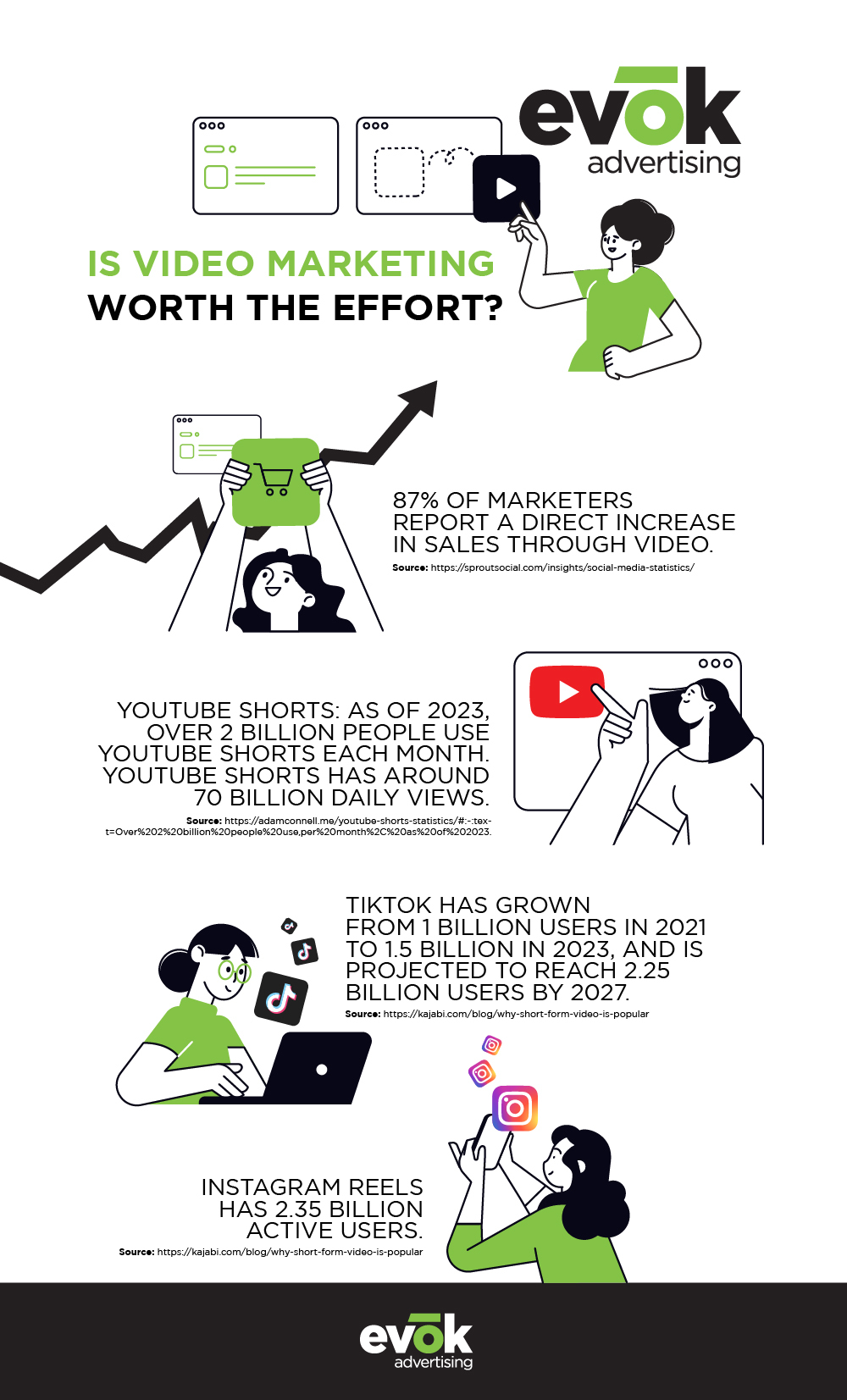
Video Marketing Strategies: How to Successfully Implement Social Media Video Marketing for Your Brand
Video marketing has become one of the most powerful tools for brands to engage with their audience. Product and service video content allows businesses to connect on a deeper level, build trust, and increase brand visibility. Social media platforms like Instagram, TikTok and Youtube Shorts have amplified the impact of videos, making reaching and engaging your target audience easier than ever.
With the growing demand for video content, brands need to implement effective social media video marketing strategies. The right video marketing efforts can significantly drive business growth, from increasing conversion rates to boosting click-through rates. This guide will walk you through creating a video marketing strategy your audience will resonate with and offer actionable tips for success.

Understanding Your Target Audience
As businesses craft their social media video marketing strategies, the first and most crucial step is understanding who they’re trying to reach. In an age where consumers are constantly bombarded with content, creating videos for your specific audience is paramount to cutting through the noise. Knowing the demographics, interests, and behaviors of your target audience helps tailor video content to speak directly to their needs, desires, and pain points.
One common mistake is making content relatable to people in your own industry rather than your target customers. For example, social media managers often create videos about the day-to-day challenges of managing social accounts, which may be entertaining for other social media professionals but miss the mark for the product or service’s real target audience.
The numbers back it up: personalized content significantly increases engagement rates. Focusing on what truly matters to your audience can boost click-through and conversion rates. Whether you aim to promote your products or services or build brand awareness, a deep understanding of your target audience allows for more effective storytelling and impactful calls to action.
Creating a Video Marketing Strategy

A successful video marketing strategy doesn’t just happen—it’s built on careful planning and execution. To stand out in a crowded digital landscape, businesses must craft a strategy to help accomplish their overall marketing goals. Here’s a breakdown of the key steps to develop a comprehensive video marketing strategy.
1. Define Your Goals
The first step in creating a video marketing strategy is to set clear, measurable goals. Are you looking to increase brand awareness, drive traffic to your landing pages, boost conversions, or improve engagement on social media platforms? Identifying these objectives will guide the rest of your strategy, from the type of videos you create to how you measure success. Each video should connect to a business goal.
2. Set Your Budget
Budgeting is crucial for any marketing initiative, and video marketing is no different. Your budget will influence every aspect of your strategy, from video production quality to the platforms you can leverage for distribution. Whether you’re creating high-end productions or simple, short-form content, allocate any necessary funds for every stage of the process, including production, editing, promotion, and ad spend. Well-crafted, engaging videos can still deliver impressive results even with a limited budget.
3. Choose the Right Platforms
Not all platforms are created equal, and choosing the ones your audience is on is essential. Platforms like Instagram, TikTok and Youtube Shorts are ideal for short-form, visually engaging content, while traditional YouTube videos are perfect for longer, more in-depth videos. Understanding where your target audience spends their time can ensure your videos reach the right people. Each platform has unique strengths and content styles, so tailor your videos to maximize engagement and conversion rates.
4. Plan Your Video Production Process
The video production process involves several stages, from ideation and scripting to filming and editing. Start by outlining the type of videos you plan to create, such as product demos, educational videos, or behind-the-scenes content. Consider whether you’ll produce the videos in-house or outsource to a professional production team. Planning ahead ensures a smoother production process and helps avoid costly mistakes or delays.
5. Landing Pages and Calls to Action (CTAs)
An essential part of any video marketing strategy is converting viewers into customers, and this is where landing pages and calls to action (CTAs) come in. A well-placed CTA can guide viewers from watching your video to taking the next step, for example, visiting your website, signing up for a newsletter, or purchasing a product.
Landing pages also play a crucial role in your video marketing efforts. Directing viewers to optimized landing pages corresponding to the video’s message can significantly increase conversion rates. These pages should be simple, user-friendly, and designed to lead the viewer toward a specific action, like filling out a form or completing a purchase. Connecting your videos to targeted landing pages creates a seamless customer journey, maximizing the impact of your video content.
The Role of Short-Form Video Content

In recent years, short-form video content has become a dominant force in social media marketing. Platforms like TikTok, Instagram Reels and Youtube Shorts have exploded in popularity, driven by their ability to deliver quick, engaging content keeping viewers coming back for more. For brands, short-form videos can capture attention in mere seconds, driving engagement and conversions.
Why Short-Form Video Works
Short-form videos are particularly effective because they cater to the decreasing attention span of modern audiences. These videos typically range from 15 to 60 seconds, making them easily digestible and shareable. This content’s rapid, snackable nature helps increase click-through rates and encourages more frequent interactions with your brand.
This format is also ideal for mobile viewing, as most users scroll through social media on their phones. Short-form videos enable brands to deliver their message quickly and efficiently, whether it’s a quick product demo, a behind-the-scenes look, or user-generated content.
Creating Effective Short-Form Videos
To succeed with short-form video, creating content that resonates with your target audience is important. Consider the following when developing your videos:
- Keep It Relatable: Make sure your content speaks to your audience’s everyday challenges, interests, or humor. Relatable content is more likely to be shared, driving reach and engagement.
- Be Clear and Concise: With limited time, getting to the point quickly is crucial. Focus on delivering a single, clear message and include a strong call to action (CTA) that encourages viewers to take the next step.
- Use Trends Wisely: Platforms like TikTok thrive on trends, and participating in popular challenges or using trending audio can help your videos gain traction. However, always ensure that trends align with your brand’s message and values.
- Leverage User-Generated Content: Incorporating user-generated content (UGC) into your short-form videos can enhance authenticity and trust. Encourage your customers to share videos of them using your products or services and feature their content on your social media channels.
Driving Engagement and Conversions
While short-form video is often associated with high engagement, it can also be a powerful driver of conversions. You can turn viewers into leads or customers by including strong CTAs and linking directly to landing pages. Additionally, you can use short-form videos in ads to retarget audiences, keeping your brand top of mind and driving them further down the marketing funnel.
Short-form videos also provide valuable data. By monitoring metrics like engagement rates, video views, and completion rates, you can assess how well your videos resonate with your audience and adjust your strategy accordingly.
Leveraging Social Media Platforms for Video Marketing
Different social media platforms offer unique opportunities for video marketing, and knowing how to leverage each one is essential for maximizing your reach and engagement. From Instagram’s focus on visuals to TikTok’s viral potential, each platform has its strengths, and your video marketing efforts should be tailored accordingly.
Instagram, TikTok and Youtube Shorts: Short-Form Video Powerhouses
Instagram and TikTok have become dominant platforms for short-form video content, offering businesses a chance to showcase their products or services in creative, engaging ways.
- Instagram: With features like Reels and Stories, Instagram allows brands to connect with their audience through visually rich, snackable content. Reels can drive high engagement with their algorithmic boost, while Stories offer a more personal, behind-the-scenes feel that humanizes your brand.
- TikTok: Known for its viral short-form content, TikTok’s algorithm can amplify your videos to reach a wide audience quickly, even if your account is new. TikTok’s informal, fun vibe allows brands to experiment with creativity, whether through challenges, trending sounds, or educational videos.
- YouTube Shorts: Shorts allow creators and brands to experiment with snappy, under-60-second videos that drive engagement and quickly capture viewers’ attention. Brands can use it to post teasers, behind-the-scenes clips, or quick how-to videos that lead viewers to their long-form content or website.
YouTube: The Hub for Long-Form and Educational Content
YouTube remains the go-to platform for longer, more in-depth video content. Whether it’s educational videos, product tutorials, or interviews, YouTube allows brands to provide value in a format users can revisit repeatedly.
YouTube also offers powerful SEO benefits. With the right keywords and optimized titles, your video content can rank in search engine results, driving organic traffic to your channel and website over time. For brands who want to establish authority and trust, YouTube’s long-form video content is a powerful tool for deepening relationships with their audience.
Facebook: Versatility in Video Content
Facebook offers a variety of video formats, such as Stories, Live videos, Reels, and horizontal feed videos. It’s a versatile platform for both short and long-form content. It’s also highly targeted, allowing businesses to use Facebook Ads to deliver video content directly to their desired audience based on demographic, interest, and behavioral data.
Facebook’s robust analytics tools also allow you to track engagement and conversions, helping you refine your video marketing strategy to achieve optimal results.
LinkedIn: B2B Video Marketing
For B2B marketers, LinkedIn is a powerful platform for distributing video content. From sharing thought leadership videos to promoting webinars or product demos, LinkedIn videos can help position your brand as an industry leader. The platform’s professional focus makes it an ideal place to connect with decision-makers and professionals looking for solutions your brand can offer.
LinkedIn also supports video ads, which can be targeted to specific industries, job titles, and company sizes. This makes LinkedIn a highly efficient tool for reaching the right audience with your video marketing efforts.
User-Generated Content and Educational Videos: Building Trust and Providing Value

In video marketing, authenticity and value are two of the most powerful elements for fostering audience trust and engagement. By incorporating User-Generated Content (UGC) and creating Educational Videos, brands can achieve both, providing content for their target audience while building credibility and customer loyalty.
The Power of User-Generated Content (UGC)
User-generated content (UGC) involves showcasing videos created by your customers, giving potential buyers a genuine look at how your products or services work in the real world. UGC adds authenticity, as it’s created by real users rather than the brand itself, making it a highly trusted form of content. According to recent studies, consumers are more likely to trust recommendations from other users than branded content, which is why UGC has become a go-to strategy for many businesses.
Incorporating UGC into your video marketing efforts also allows you to tap into the experiences of satisfied customers, turning them into advocates for your brand. Whether unboxing videos, product reviews, or customer testimonials, UGC can provide fresh, relatable perspectives, helping potential customers feel more confident about purchasing.
Many brands have successfully used UGC in their social media video marketing strategies. For instance, GoPro often features videos shot by its customers, highlighting the product’s capabilities through real-life use. Similarly, beauty brands like Glossier encourage customers to share their makeup routines using branded hashtags, which they then repost, creating a cycle of engagement and trust.
Educational Videos: Adding Value Through Information
Educational videos are a key tool for providing value to your audience, offering solutions, tips, or insights directly addressing their needs. These videos can take many forms, from how-to guides and product tutorials to explainer videos, simplifying complex concepts. Educational videos help potential customers understand your products or services and position your brand as a knowledgeable and helpful resource in your industry.
For instance, brands like HubSpot and Moz use educational content to offer valuable marketing tips and strategies. At the same time, tech companies like Apple and Microsoft create in-depth product demos to show customers how to use their tools effectively. By helping your audience solve problems or learn something new, you build trust and loyalty, making them more likely to engage with your brand in the future.
Maximizing Your Social Media Video Marketing Efforts

As video continues to dominate social media, having a well-thought-out video marketing strategy is crucial for any brand looking to stay competitive. From incorporating user-generated content and educational videos to leveraging the power of platforms like Instagram and TikTok, video content can drive meaningful engagement, boost conversion rates, and build lasting relationships with your audience.
Understanding your target audience, creating relatable and informative videos, and optimizing your content for the right social media platforms can help your brand effectively reach potential customers and turn views into valuable conversions.Ready to take your video marketing strategy to the next level? Contact us to connect with our team of experts who can help you create powerful, results-driven video content that resonates with your audience and enhances your social media marketing efforts.